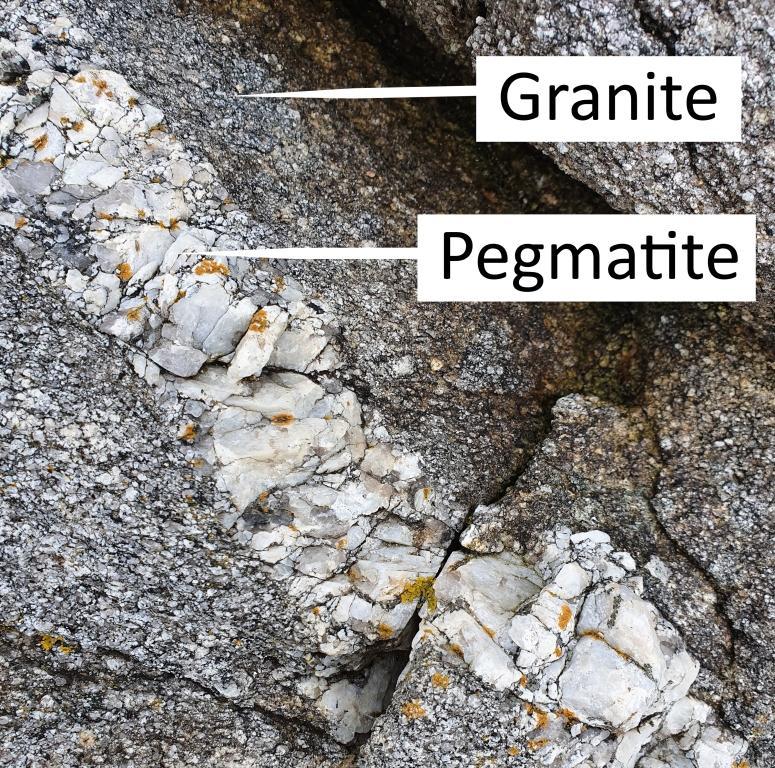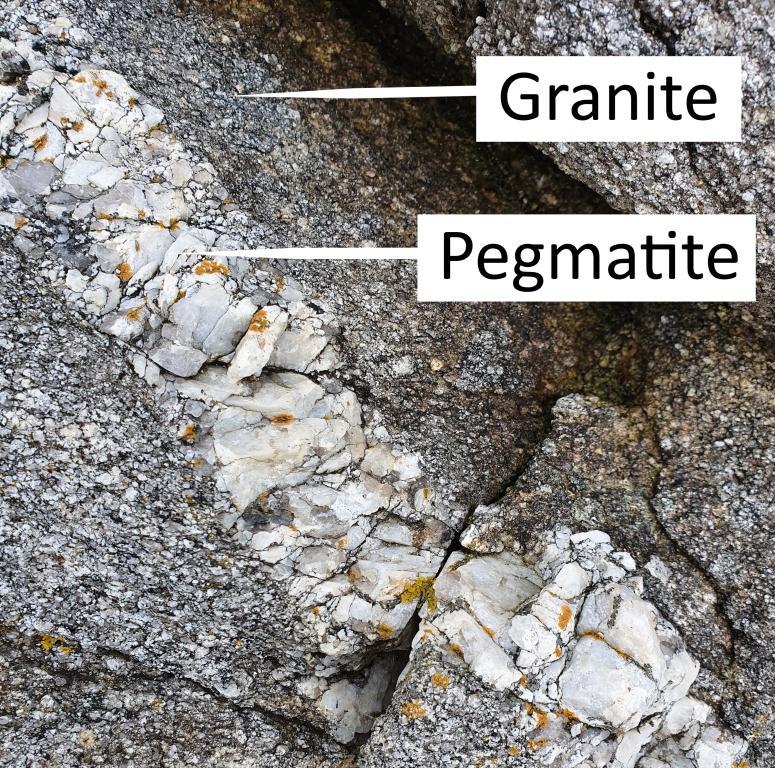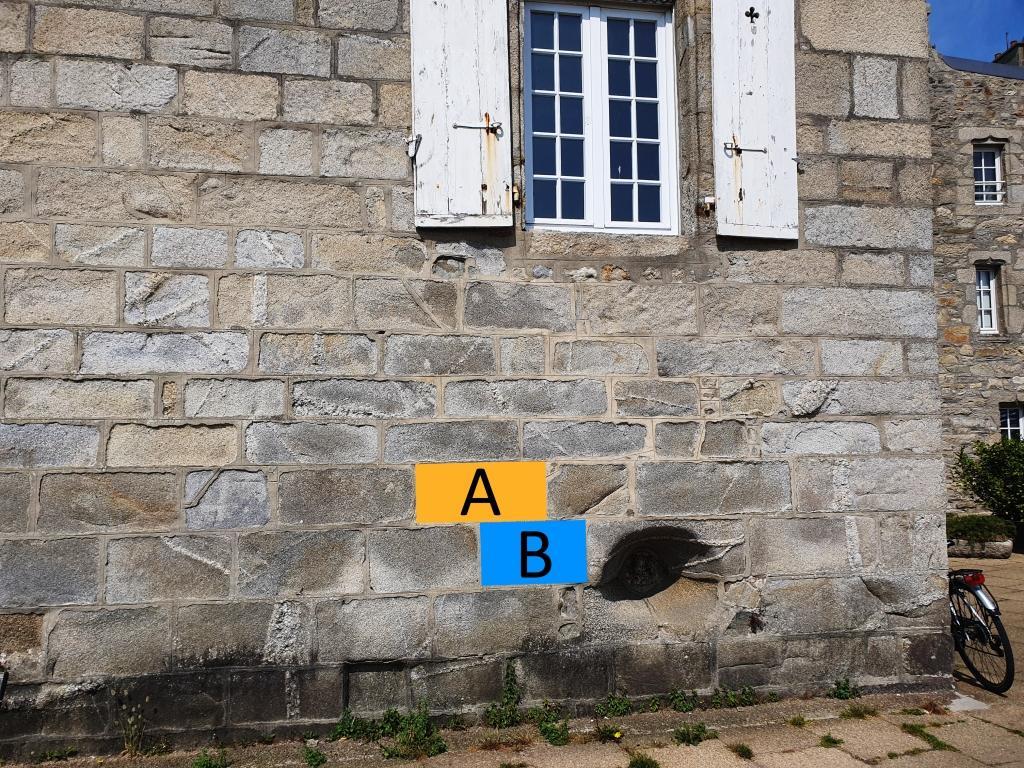Il s'agit d'une Earthcache, il n'y a pas de récipient à chercher.
Météorisation à Roskoff
Granite de l’île de Batz
Les anciennes bâtisses à Roskoff sont souvent construites en granite de l’île de Batz. C’est un granite de teinte gris clair, de grain généralement fin. Le granite est très régulièrement recoupé pas des veines de pegmatites. Le granite de l’île de Batz appartient au massif de Roscoff dont il constitue la bordure nord. Le granite est issu de la cristallisation en profondeur d’un magma qui a pour origine la fusion de la base de la croûte continentale vers 700°C et environ 100 km de profondeur.
Sa mise en place est en relation avec l’orogenèse hercynienne, il y a environ 320 millions d’années, à la fin des temps primaires (ou Paléozoïque) qui a vu s’édifier une vaste chaîne de montagnes sur une grande partie de ce qui est aujourd’hui l’Europe. La Bretagne se situait alors au sein d’un vaste continent, à peu près au niveau de l’Equateur. Ce continent s’est ensuite disloqué tandis que l’Océan Atlantique s’ouvrait et que la Bretagne dérivait vers le nord. Depuis, durant des millions d’années, l’érosion a nivelé ces montagnes et porté le granite à l’affleurement sous des climats chauds et humides qui ont favorisé l’altération des roches.

Pegmatite
Les pegmatites forment des filons (poches ou veines), en bordure ou au voisinage immédiat des plutons granitiques auxquels elles sont génétiquement associées (elles ont une composition voisine). Elles correspondent généralement au liquide résiduel, riche en eau, de fin de cristallisation d'un magma granitique (jus résiduel siliceux). Il est leucocrate (teinte claire), car les minéraux sombres (ferromagnésiens) comme la biotite ont une température de fusion (et donc de cristallisation) beaucoup plus élevé (850 degrés) que les minéraux siliceux (quartz et feldspaths), donc il n'y en pas dans les jus résiduels qui sont les derniers à se solidifier. Dans le jus résiduel siliceux se concentrent des éléments rares dits "incompatibles" (B, Be, Nb, Ta, etc...)
En dehors de la différence de teinte leucocrate, la pegmatite se caractérise par la taille des cristaux qui la constituent. Leur taille est beaucoup plus grande que la taille des cristaux du granite voisin. En général plus la taille des cristaux est grande plus le refroidissement du magma était long. Ici du fait de la présence des éléments fondants (certains éléments rares) qui abaissent le point de fusion, la viscosité du magma, et le taux de nucléation, le filon lié à l'intrusion magmatique représente une phase pegmatitique (entre 800° et 600°) qui voit l'augmentation du taux de croissance des cristaux et un temps de refroidissement qui n'a pas besoin d'être très long.
Altération météorique
La météorisation, appelée aussi altération météorique, altération atmosphérique ou altération climatique, est l’ensemble des processus mécaniques, physico-chimiques ou biologiques de réduction élémentaire des roches et des minéraux à la surface de la Terre par les agents météoriques (appelés aussi météores, il s'agit principalement de l'eau, des gaz atmosphériques et des variations de température), mécaniques ou biologiques ; ils constituent la réponse des minéraux d’une roche pour trouver un équilibre s’ajustant avec les conditions d’eau et d’air à la surface terrestre. L’altération du granite se développe préférentiellement sur les versants exposés aux embruns ou aux vents humides. Cette altération qui affecte surtout les roches magmatiques grenues (granite) et les roches sédimentaires gréseuses dont l'hétérogénéité est propice à l'action de l'érosion différentielle, se conjugue avec des phénomènes d'hydratation qui contribuent à désagréger les cristaux, et avec la déflation éolienne qui intervient pour évacuer les débris fins.
L’érosion différentielle
L'érosion différentielle est la composante d'irrégularité de l'érosion résultant des différences de résistance des matériaux. Elle provoque une mise en relief des zones résistantes au détriment des zones tendres, créant ce qui est appelé des figures d'érosion selon l'échelle considérée. Cette composante est ainsi déterminante dans l'érosion littorale avec la formation du trait de côte, ou dans les sculptures ou excavations produites par l'érosion éolienne (par corrasion, déflation…).
Aspects colorimétriques (auréoles de rouille)
La météorisation des surfaces rocheuses se traduit notamment et souvent par un changement de couleur ou une décoloration superficielle de la roche. Cette enveloppe colorée est appelée "cortex de météorisation" ; elle peut servir à dater la durée d'exposition d'une roche ou l'âge d'un dépôt. Ainsi on trouve des auréoles de rouille dans un granite altéré, qui a été exposé à l’eau. Cette teinte brunâtre est généralement due à la diffusion d'hydroxyde de fer du type limonite, liée à la décomposition des minéraux ferrifères (biotite, pyrite).
Sources
Wikipedia
https://www.geowiki.fr/
Une roche identitaire, Le Granite de l’île de Batz (Finistère)
https://www.geoportail.gouv.fr/donnees/cartes-geologiques
https://planet-terre.ens-lyon.fr/
Questions pour valider cette Earthcache :
A l’aide de la Photo 1, identifiez les zones A et B.
- Observez la zone A et décrivez-la : vous y trouvez le granite, la pegmatite ou les deux ?
- Quel phénomène du descriptif vous pouvez-y observer ?
- Observez la zone B et décrivez-la : vous y trouvez le granite, la pegmatite ou les deux ?
- Quel phénomène du descriptif vous pouvez-y observer ?
- Une photo de vous ou d’un objet vous représentant sur le site.
 Photo 1
Photo 1
Loguez cette cache "Found it" et envoyez-moi vos propositions de réponses soit via mon profil, soit via la messagerie geocaching.com (Message Center), et je vous contacterai en cas de problème. Les logs enregistrés sans réponses seront supprimés.
English version
This is an Earthcache, there is no container to look for.
Weathering at Roskoff
Granite from the island Batz
The old buildings in Roskoff are often made of granite from the island Batz. It is a light gray granite with a generally fine grain. The granite is very regularly intersected by pegmatite veins. The granite of the island Batz belongs to the Roscoff massif of which it forms the northern edge. Granite comes from the deep crystallization of a magma which originates from the melting of the base of the continental crust at around 700°C and around 100 km deep.
Its establishment is related to the Hercynian orogeny, about 320 million years ago, at the end of primary times (or Paleozoic) which saw the construction of a vast chain of mountains over a large part of this which is Europe today. Brittany was then located within a vast continent, roughly at the level of the Equator. This continent then broke apart as the Atlantic Ocean opened up and Brittany drifted north. Since then, over millions of years, erosion has leveled these mountains and brought the granite to the outcrop in hot and humid climates that have favored the weathering of the rocks.

Pegmatite
The pegmatites form veins (pockets or veins), on the edge or in the immediate vicinity of the granitic plutons with which they are genetically associated (they have a similar composition). They generally correspond to the residual liquid, rich in water, from the end of crystallization of a granitic magma (siliceous residual juice). It is leucocratic (light tint), because dark minerals (ferromagnesians) like biotite have a much higher melting (and therefore crystallization) temperature (850 degrees) than siliceous minerals (quartz and feldspars), so it does not There are none in the residual juices which are the last to solidify. In the siliceous residual juice are concentrated rare elements called "incompatible" (B, Be, Nb, Ta, etc.)
Apart from the difference in leucocratic hue, pegmatite is characterized by the size of the crystals that constitute it. Their size is much larger than the size of the crystals of the neighboring granite. In general, the larger the size of the crystals, the longer the cooling of the magma. Here, due to the presence of melting elements (certain rare elements) which lower the melting point, the viscosity of the magma, and the rate of nucleation, the vein linked to the magmatic intrusion represents a pegmatitic phase (between 800° and 600° °) which sees the increase in the growth rate of the crystals and a cooling time which does not need to be very long.
Meteoric Alteration
Weathering, also called meteoric alteration, atmospheric weathering or climatic weathering, is the set of mechanical, physico-chemical or biological processes of elementary reduction of rocks and minerals on the surface of the Earth by meteoric agents (also called meteors, these are mainly water, atmospheric gases and temperature variations), mechanical or biological; they are the response of the minerals of a rock to find a balance adjusting with the water and air conditions on the earth's surface. Granite weathering develops preferentially on slopes exposed to spray or wet winds. This alteration, which mainly affects granular magmatic rocks (granite) and sandstone sedimentary rocks whose heterogeneity is conducive to the action of differential erosion, is combined with hydration phenomena which contribute to breaking up the crystals, and with wind deflation which intervenes to evacuate the fine debris.
Differential erosion
Differential erosion is the irregularity component of erosion resulting from differences in material strength. It causes a highlighting of the resistant zones to the detriment of the soft zones, creating what are called erosion figures according to the scale considered. This component is thus decisive in coastal erosion with the formation of the coastline, or in the sculptures or excavations produced by wind erosion (by corrosion, deflation, etc.).
Colorimetric aspects (rust halos)
The weathering of rock surfaces is reflected in particular and often by a change in color or a superficial discoloration of the rock. This colored envelope is called the "bloat cortex"; it can be used to date the duration of exposure of a rock or the age of a deposit. Thus we find rings of rust in an altered granite, which has been exposed to water. This brownish color is generally due to the diffusion of iron hydroxide of the limonite type, linked to the decomposition of ferriferous minerals (biotite, pyrite).
Questions to validate this Earthcache:
Using Photo 1, identify areas A and B.
1. Observe zone A and describe it: do you find granite, pegmatite or both?
2. What phenomenon of the description can you observe there?
3. Observe zone B and describe it: do you find granite, pegmatite or both?
4. What phenomenon of the description can you observe there?
5. A photo of you or an object representing you on the site.

Photo 1
Log this "Found it" cache and send me your suggested answers either via my profile or via geocaching.com (Message Center), and I will contact you in the event of a problem. Logs recorded without response will be deleted.